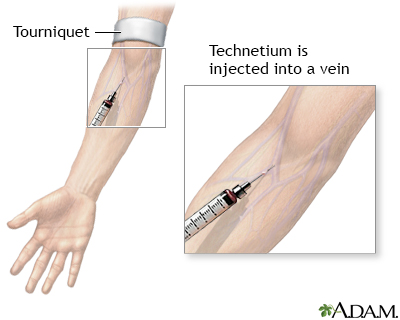Liver scan
Technetium scan; Liver technetium sulfur colloid scan; Liver-spleen radionuclide scan; Nuclear scan - technetium; Nuclear scan - liver or spleen
A liver scan uses a radioactive material to check how well the liver or spleen is working and to assess masses in the liver.
Images

I Would Like to Learn About:
How the Test is Performed
The health care provider will inject a radioactive material called a radioisotope into one of your veins. After the liver has soaked up the material, you will be asked to lie on a table under the scanner.
The scanner can tell where the radioactive material has gathered in the body. Images are displayed on a computer. You may be asked to remain still, or to change positions during the scan.
How to Prepare for the Test
You will be asked to sign a consent form. You will be asked to remove jewelry, dentures, and other metals that can affect the scanner's functions.
You may need to wear a hospital gown.
How the Test will Feel
You will feel a sharp prick when the needle is inserted into your vein. You should not feel anything during the actual scan. If you have problems lying still or are very anxious, you may be given a mild medicine (sedative) to help you relax.
Why the Test is Performed
The test can provide information about liver and spleen function. It is also used to help confirm other test results.
The most common use for a liver scan is to diagnose a condition called benign focal nodular hyperplasia, or FNH, which causes a non-cancerous mass in the liver.
Normal Results
The liver and spleen should look normal in size, shape, and location. The radioisotope is absorbed evenly.
What Abnormal Results Mean
Abnormal results may indicate:
- Focal nodular hyperplasia or adenoma of the liver
- Abscess
- Budd-Chiari syndrome
- Infection
- Liver disease (such as cirrhosis or hepatitis)
- Superior vena cava obstruction
- Splenic infarction (tissue death)
- Tumors
Risks
Radiation from any scan is always a slight concern. The level of radiation in this procedure is less than that of most x-rays. It is not considered to be enough to cause harm to the average person.
Pregnant or nursing women should consult their provider before any exposure to radiation.
Considerations
Other tests may be needed to confirm the findings of this test. These may include:
This test is used infrequently. Instead, MRI or CT scans are more often used to evaluate the liver and spleen.
Related Information
Liver diseaseCirrhosis
Hepatitis
Abscess
SVC obstruction
Splenic infarction
Hepatic vein obstruction (Budd-Chiari)
Amebic liver abscess
Liver cancer - hepatocellular carcinoma
References
Mettler FA, Guiberteau MJ. Gastrointestinal tract. In: Mettler FA, Guiberteau MJ, eds. Essentials of Nuclear Medicine and Molecular Imaging. 7th ed. Philadelphia, PA: Elsevier; 2019:chap 7.
Squires JH, Narayanan S, Tadros S. Fundamentals of pediatric radiology. In: Zitelli BJ, McIntire SC, Nowalk AJ, Garrison J, eds. Zitelli and Davis' Atlas of Pediatric Physical Diagnosis. 8th ed. Philadelphia, PA: Elsevier; 2023:chap 25.
Tirkes T, Sandrasegaran K. Investigative imaging of the liver. In: Saxena R, ed. Practical Hepatic Pathology: A Diagnostic Approach. 2nd ed. Philadelphia, PA: Elsevier; 2018:chap 4.
BACK TO TOPReview Date: 1/1/2025
Reviewed By: Jason Levy, MD, FSIR, Northside Radiology Associates, Atlanta, GA. Also reviewed by David C. Dugdale, MD, Medical Director, Brenda Conaway, Editorial Director, and the A.D.A.M. Editorial team.

Health Content Provider
06/01/2025
|
A.D.A.M., Inc. is accredited by URAC, for Health Content Provider (www.urac.org). URAC's accreditation program is an independent audit to verify that A.D.A.M. follows rigorous standards of quality and accountability. A.D.A.M. is among the first to achieve this important distinction for online health information and services. Learn more about A.D.A.M.'s editorial policy, editorial process and privacy policy. A.D.A.M. is also a founding member of Hi-Ethics. This site complied with the HONcode standard for trustworthy health information from 1995 to 2022, after which HON (Health On the Net, a not-for-profit organization that promoted transparent and reliable health information online) was discontinued. |
The information provided herein should not be used during any medical emergency or for the diagnosis or treatment of any medical condition. A licensed medical professional should be consulted for diagnosis and treatment of any and all medical conditions. Links to other sites are provided for information only -- they do not constitute endorsements of those other sites. © 1997- 2025 A.D.A.M., a business unit of Ebix, Inc. Any duplication or distribution of the information contained herein is strictly prohibited.
